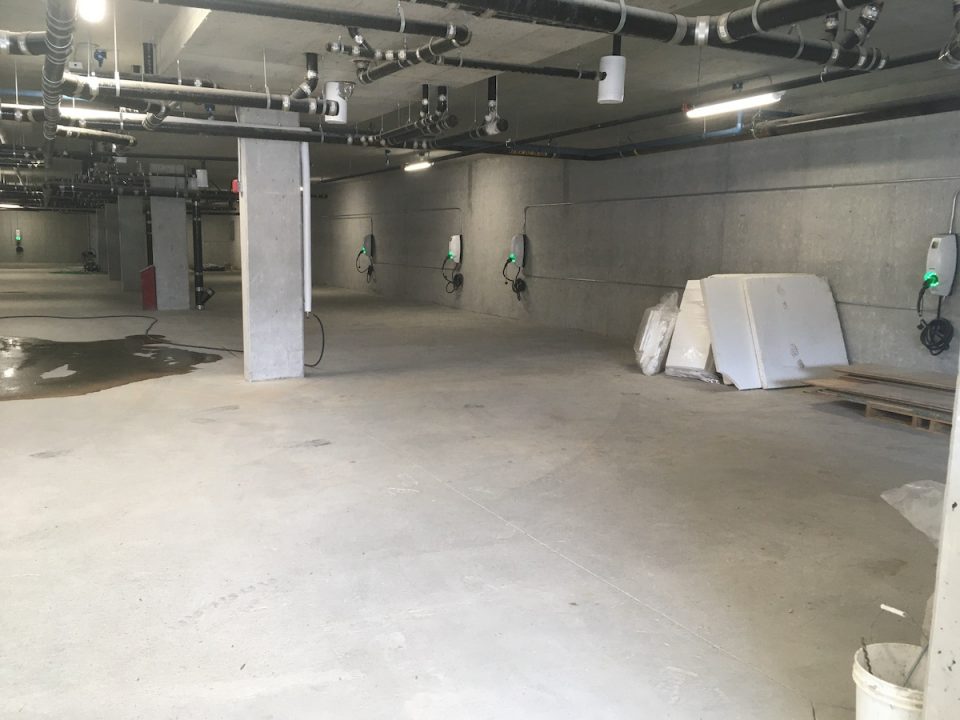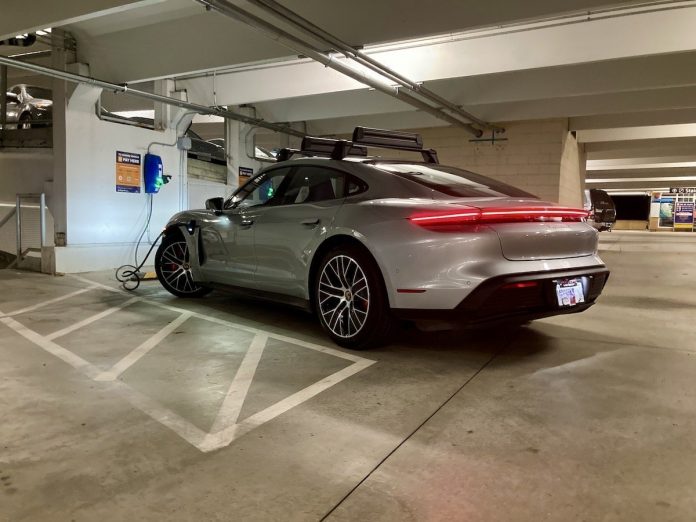It’s common knowledge that 100 per cent EV charging rough-in with wire is required in new residential buildings across most of Metro Vancouver. Planning for a new construction project requires several areas of consulting: architectural, structural, mechanical and electrical engineering, HVAC systems, and more, to meet regulations as well as certifications such as LEED.
Municipal regulations mandate that there is an available electrical outlet or junction box to install a charging station on all residential parking stalls. Without a doubt, a load sharing solution will be implemented to provide electrical power to all stalls to avoid a significant increase in electrical infrastructure. For that system to work, smart charging stations will be required to perform the load sharing as initially designed in the electrical drawing phase.
New buildings
The best time to think about EV charging infrastructure is at the electrical engineering phase. One of the most important aspects of future-proofing a new building is the initial electrical infrastructure.
Here are a few things to carefully consider:
- 100 per cent of residential stalls need to be EV Ready
- 10-20 per cent of commercial stalls need to be EV Ready
- What type of load sharing would be best for the building setup?
- Nema outlet vs. junction box
- Type of load sharing (Panel, circuit, dynamic, DCC, etc.)
- Room for expansion on the electrical infrastructure (future-proofing)
- Mix-buildings will most likely require a mix of two approaches
The second most important factor to keep in mind is that the first charging unit in the building offers the most flexibility when connecting to a network provider and to (4G/wi-fi/proprietary gateways).
To provide such flexibility, verify with your EV charging station provider that the proposed charging stations are currently working on multiple network providers. Doing so will avoid installing charging stations that can only be connected to one network provider, resulting in a vendor lock-in solution for the lifetime of the charging units, as well as future expansion in the building.
Beware that “roaming agreements” are different from being connected to a different network.
It is very useful from a user perspective, however, it doesn’t improve the solution for the charging stations’ owner as the charging units will still connect to only one network provider.

Finally, the type of building is extremely important to consider.
As there is no one size-fit-all solution, the best charging solution will differ for a condo, rental, commercial or office building. A mix-use building will require at least two different EV strategies. Even a residential project with a mix of townhomes and a parkade will require two different kinds of charging equipment to maximize power use while reducing overall costs.
Retrofits
In a retrofit scenario, the considerations are very similar to a new build. However, since there is no option to start from scratch, property owners need to carefully understand all their options.
Hiring a local vendor-agnostic EV charging service provider would be the first step to assess the existing infrastructure. Unlike contacting a manufacturer directly, an EV charging specialist will be able to provide a solution that considers what the industry as a whole offers in terms of equipment and solutions, which can result in huge savings for the property owners.
When working on a retrofit, it is most important to not only look at today’s EV needs but also future needs.
As the uptake of electric vehicles is on a steep climb, retrofitting the electrical infrastructure (and potentially civil work) every time a new charging station is needed will end-up being a very costly strategy. CleanBC in partnership with BC Hydro have launched an EV Ready Plan program with a $3,000 rebate to that effect.

Government rebates and carbon credits
Government EV rebates
Many governments are currently including EV charging infrastructure in their annual budget to help service the thousands of new electric vehicles taking to the road each year.
This is mostly part of the governments’ green initiatives to lower carbon emissions around the world. Canada and the U.S. have already been taking a particularly strong position in 2021.
Federal and provincial governments offer different programs, and they are typically broken down by: sector, type of building, or type of charging infrastructure (level 2 or 3). It is increasingly important to understand the structure of each offering to best align with a project timeline, type of building, corporate fleet, or level 2 or 3 charging infrastructure project.
In cases where larger organizations are operating a provincial/state or nationwide portfolio, the best strategy could be to apply to multiple EV rebate programs and maximize the cost benefit.
The federal ZEVIP program has an application deadline for mid-June 2021. Contact us for assistance with the application process.
Carbon credits and EV charging
In the last couple of years, there have been a lot of discussions at the federal and provincial levels about the soon to be distributed carbon credits generated from the EV charging stations.
This is a progressive program to incentivize organizations to invest in EV charging stations whether public or private. Following strong lobbying from big industry players, the current version of the Clean Fuel Standard (CFS) overseen by Environment Climate Change Canada (ECCC) is granting (by default) all carbon credits generated from public and residential charging stations to the network providers.
As most real estate industry players are not aware of such programs, it means that whoever is investing in the initial charging infrastructure will not reap the benefit of the carbon credits, but rather the network provider being paid to manage those stations. Please connect with us to learn more.
How to generate revenue from residential EV charging stations
One of the main questions we hear is: “How can I generate revenue from charging stations?”
It’s one thing to put them in and pay for them but how do you get your initial investment back? There are a few key ways to generate a profit, whether it’s a new condo building or rental property. Using a presell or pre-lease form is the easiest way to generate a healthy margin.
To generate an ROI on commercial properties, a completely different approach needs to be implemented. Costs can be recovered via implementing a nominal $/hr rate to users as the charger utilization rate is not quite mature enough to generate a traditional payback period for infrastructure investment.
Payback mostly comes from bringing more people to the site who will either spend money or visit an area. As people like routines, it creates recurring visitors making it important to be first to capture new customers by providing additional services that enhance the experience.
Sustainability
Greening the transportation system is crucial to reducing the carbon emissions added to the atmosphere. Most, if not all the attention, is currently on the life cycle of the electric vehicle itself, and little to none on the sustainability of the charging infrastructure.
To maximize carbon reduction, implementing a flexible, interoperable, and future-proof approach to every EV charging site is key. There is no sustainability in replacing a charging station in good condition just because of a software update, running a rip and replace program to boost sales or because a site host decides to switch network providers.
The same is true about replacing level 3 charging stations with a faster unit, when there are upgradable options on the market. Building and designing sites to last and to minimize future civil work for expansion is also a sound way to minimize long-term costs and environmental impact. Designing with inclusivity in mind is also essential, such as incorporating handicap access to at least one charging station per site as it avoids remodelling the charging site in the future.
Many players are taking a solo approach by trying to dominate the market regardless of the impact or long-term consequences on the client. However, chasing a much bigger sustainability goal benefiting the investor in EV charging will only happen by working together.
About LeadingAhead Energy (LAE)
LeadingAhead Energy is a specialist consultancy firm operating in the real estate sector since 2017. LAE advises on the design, planning and delivery of electric vehicle (EV) charging infrastructure projects. The company has advised and project-managed over 100 new and retrofit EV charging projects across North America on level 2 and level 3. Our innovative thinking applied on site designs and future-proofing infrastructure have been used by governments to build their EV best practice guidelines.
A key differentiator from the many EV market operators is that LeadingAhead Energy is an expert in overall EV charging technologies on the market. The company is not tied to any market offering and its sole interest is to advise its clients on the best available market solutions for a specific site.
LAE provides independent advice on the fast moving and crowded EV charging solutions market and is constantly monitoring new offerings and solutions, not only in North America but all over the world to best advise our clients and drive the Canada EV charging industry forward.
Visit our website www.leadingaheadenergy.com to learn more.




